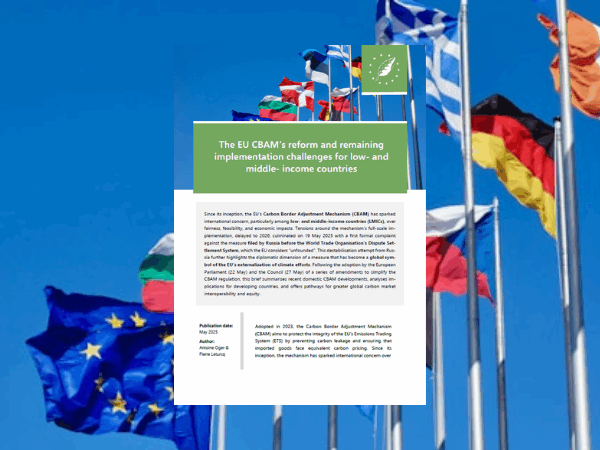AUTHORS: Antoine Oger and Pierre Leturcq
Following the adoption by the European Parliament (22 May 2025) and the Council (27 May 2025) of a series of amendments to simplify the CBAM regulation, this briefing summarises recent domestic CBAM developments, analyses implications for developing countries, and offers pathways for greater global carbon market interoperability and equity.
Since its inception, the EU’s Carbon Border Adjustment Mechanism (CBAM) has sparked international concern, particularly among low- and middle-income countries (LMICs), over fairness, feasibility, and economic impacts. Tensions around the mechanism’s full-scale implementation, delayed to 2026, culminated on 19 May 2025 with a first formal complaint against the measure filed by Russia before the World Trade Organisation’s Dispute Settlement System, which the EU considers “unfounded”. This destabilisation attempt from Russia further highlights the diplomatic dimension of a measure that has become a global symbol of the EU’s externalisation of climate efforts.
Following the adoption by the European Parliament (22 May 2025) and the Council (27 May 2025) of a series of amendments to simplify the CBAM regulation, this briefing summarises recent domestic CBAM developments, analyses implications for developing countries, and offers pathways for greater global carbon market interoperability and equity.
Key Recommendations
- Finalise simplification reforms to ensure SMEs, both in the EU and globally, are treated equitably
- Expand CBAM scope to incentivize circular economy practices and capture emissions from downstream products.
- Support LMIC readiness through financial and technical assistance for MRV systems and carbon pricing instruments.
- Enhance international alignment by recognizing alternative mitigation efforts and participating in carbon pricing dialogues.
- Allocate part of CBAM revenues to global climate finance, linking them to measurable decarbonization outcomes in exporting countries.
Briefing cover photo by Antoine Schibler on Unsplash


